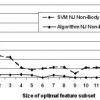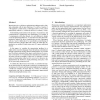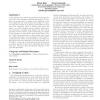341 search results - page 61 / 69 » Redundancy elimination revisited |
CPP
2011
12 years 7 months ago
2011
Parsing text to identify grammatical structure is a common task, especially in relation to programming languages and associated tools such as compilers. Parsers for context-free g...
CVPR
2007
IEEE
14 years 9 months ago
2007
IEEE
Class syntax can be used to 1) model temporal or locational evolvement of class labels of feature observation sequences, 2) correct classification errors of static classifiers if ...
ICIP
2003
IEEE
14 years 9 months ago
2003
IEEE
We present algorithms for automatic feature selection for unsupervised structure discovery from video sequences. Feature selection in this scenario is hard because of the absence ...
ICFP
2009
ACM
14 years 8 months ago
2009
ACM
Memoization is a well-known optimization technique used to eliminate redundant calls for pure functions. If a call to a function f with argument v yields result r, a subsequent ca...
KDD
2008
ACM
14 years 8 months ago
2008
ACM
Closed patterns are powerful representatives of frequent patterns, since they eliminate redundant information. We propose a new approach for mining closed unlabeled rooted trees a...



